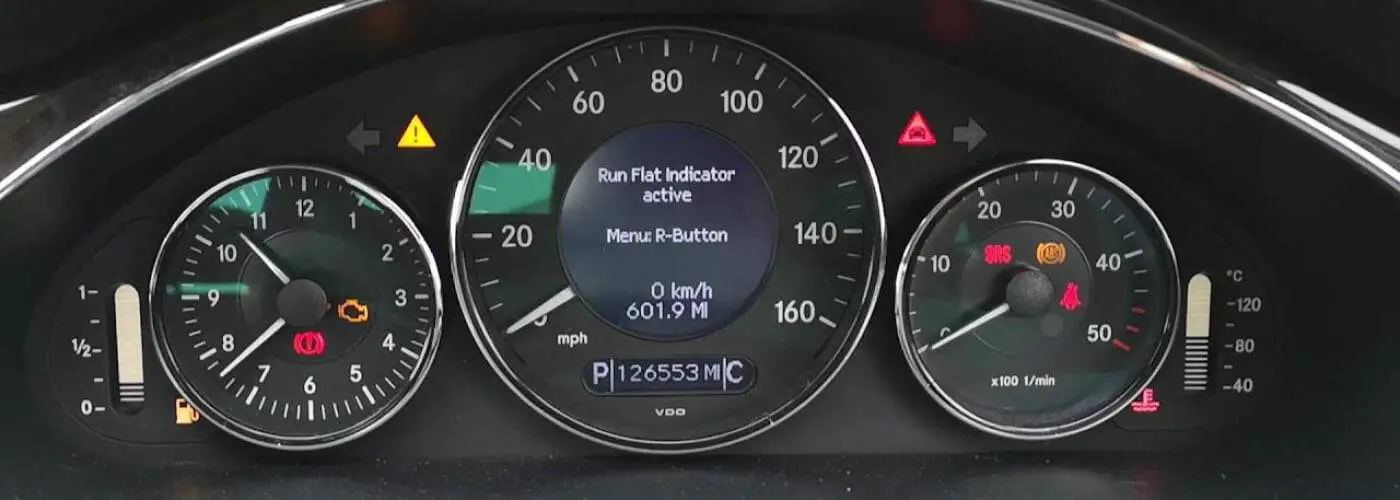Run Flat Indicator Inoperative
The Run Flat Indicator is a crucial feature in modern vehicles that signals drivers when one or more tires lose pressure. The indicator is designed to reveal the tire pressure and offer real-time feedback to the driver.
When the indicator fails to function appropriately, it will be unable to detect low tire pressure or punctures.
Consequently, drivers will not get the warning on time, which increases the danger of tire-related incidents, decreased car management, and compromised protection.
In this article, we will explore the meaning behind an inoperative Run Flat Indicator.
We will endeavor to delve into the potential causes of this problem, discuss viable solutions, and highlight unique vehicle models which have frequently experienced this issue.
What is the Run Flat Indicator?

In simple terms, the Run Flat Indicator is a function designed to alert the driver when there is a problem with one or more of the tires. This may be due to numerous reasons, including low pressure, punctures, or other issues.
It uses hard and fast sensors such as the ABS sensor and TPMS (tire pressure monitoring system) to warn you when the tires are low in pressure.
What Does “Run Flat Indicator Inoperative” Mean?
Now, let’s look at what this particular caution light means. Run Flat Indicator Inoperative appears when your car’s Powertrain Control Module (PCM) has detected a difficulty with the system.
The indicator is a warning alerting you when there is trouble with any of your tires.
The run flat tire indicator is advantageous because it facilitates careful driving while tire pressure is low, allowing for minimal movement from depleted tires [1].
It can assist in dealing with tire pressure loss, although proper tire care is required to maintain safety.
What causes the Run Flat Indicator Inoperative problem?

The problem of inoperative run flat signs is becoming more prevalent, and figuring out what’s causing it can be frustrating. There are many one-of-a-kind causes for this caution.
The following are some of the commonly identified causal reasons.
- Tire Mismatch
The most common reason for the “Run Flat Indicator Inoperative” alert is tire mismatch. If your vehicle’s tires are not the same size or have different load capacities, this is most likely the cause of your dashboard’s “Run Flat Indicator Inoperative” warning.
It would be best if you replaced the mismatched tires with fit ones. [2]
- Bad ABS Sensor
Another reason for this warning light is a faulty ABS (Anti-lock braking system) sensor. The ABS measures the vehicle’s speed, yaw, and force applied to each tire via sensors in both the front and back axles.
In case the parameters don’t match the recommended values, the dashboard will show a “Run Flat Indicator Inoperative” warning.
- Faulty Brake Light Switch
A malfunctioning brake light switch can cause the Run Flat Indicator message to appear. The switch is between your vehicle’s pedal and the electric motor.
It is mainly responsible for turning on the brake light when you step on the brake pedal. It also helps to activate the Run Flat Indicator.
If the switch is faulty and is not transmitting the correct signal to your car’s computer, it will display this warning message. [3]
- Weak Battery
A faulty battery is another typical cause of the “Run Flat Indicator Inoperative” on your car. A faulty battery cannot supply enough voltage to the velocity sensors and other electronics associated with the Run flat indicator device.
As a result, the dashboard will display a “Run flat indicator inoperative” warning.
If your vehicle’s battery is more than four years old, replacing it will almost certainly cure the problem [4].
- Problems with the Electronic Control Unit
The control unit monitors the operation of all your vehicle’s safety systems and indicators, including the Run Flat Indicator [7]. If something goes wrong with the control unit, such as a wiring issue or a faulty connection, it can cause issues with the indicator display.
If you discover that your Run Flat Indicator isn’t operating correctly, it’s worth looking into whether there’s a problem with the control unit.
- Electrical issues
The run flat indicator error may also appear if the vehicle has electrical issues, which should be addressed before attempting to resolve the issue. The alert might appear in rare situations due to a parasitic current draw while the car is parked overnight or for a few days.
An unrelated issue, such as a malfunctioning alarm siren, horn, sound system, command, or module that doesn’t sleep and drains the battery, can produce a parasitic draw. Because a low voltage was detected, these error messages occur when the car is jump-started.
How to Fix the Run-flat Indicator Inoperative Warning
Here is what you need to do to fix the Run Flat Indicator Inoperative warning.
First, check your tires for any damage. If there is no fault, test the tire pressure and ensure it suits the specifications of your manufacturer’s guide.
The next step would be to replace the ABS sensors. You may need to use an OBD2 scanner to see which sensor is probably faulty or replace all four if you find it irresistible.
If changing the ABS sensor/s doesn’t remedy the problem, test your battery to know if it’s functional. If it is wiped out, then have it replaced.
If doing these steps doesn’t fix the issue, it’s time to take your vehicle to the closest mechanic or dealer and have them diagnose the problem. If a faulty sensor is recognized as the root cause of the problem, it could need to be replaced.
Sometimes sensors can be changed without updating the entire tire pressure monitoring system. Seek advice from a qualified technician or legal service for sensor substitutes to ensure proper installation and calibration.
Furthermore, examine the vehicle’s electrical device, which includes fuses and wiring, to pick out any potential causes for the indicator to malfunction.
Sometimes, an inoperative run flat indicator can be resolved through a software program update or recalibration. Consult the vehicle’s manufacturer or dealer for guidance on these issues.
Resetting the Run Flat Indicator
In a few instances, the run flat indicator may be briefly inoperative because of a reset or calibration problem. While the precise steps for resetting the indicator can range based on the car’s make and version, the following common tips can adequately assist in resetting your vehicle [5].
- First, review your owner’s manual. It includes detailed instructions for resetting the run flat indicator and may provide specialized statistics based on the vehicle’s configuration.
- Find the reset button. Depending on the vehicle, the reset button may be located on the dashboard, the instrument cluster, or the steering wheel.
- Press and hold the reset button. To begin the reset procedure, follow the directions in the owner’s manual. Typically, this entails pressing and holding the reset button until the indicator mildly flashes or turns off.
- Verify reset success. After completing the reset, check the run flat indicator to ensure it works properly. If the problem persists, additional troubleshooting or professional assistance may be required.
Related: SOS Inoperative Mercedes
Models with the Run Flat Indicator Inoperative Issue
While inoperative run flat indications vary by vehicle type, some models have experienced this issue more frequently. This list, however, is not exhaustive.
Therefore, checking the automaker or legal service center for up-to-date records is a good idea.
A few models have observed instances of inoperative run flat indicators. The Run Flat Indicator Inoperative issue has been reported in certain generations of the BMW 3 Series, including the E90 and F30 cars.
It has also been reported in the BMW 5 Series, specifically the F10 model, and in the BMW X5 like E70 and F15.
Some Mercedes-Benz C-class and E-class models also experience this issue. These include the W204 and W205 for Mercedes-Benz C-Class and the W212 and W213 for the Mercedes-Benz E-Class models.
Read Also: Increased Steering Effort BMW
Conclusion
An inoperative run flat indicator can inconvenience and compromise driver protection by hindering the early detection of tire pressure issues.
By understanding why this happens and following the suggested steps for resolution, car owners can deal with this issue promptly.
When the run flat indicator becomes inoperative, it reduces vehicle protection and overall performance. If confronted with this problem, seeking advice from the car’s manufacturer or legal provider for an accurate prognosis and promptly clearing up the difficulty is beneficial.
Whatever the cause, having a skilled technician evaluate and diagnose the problem is the best way to assure your and others’ safety. If you receive the appropriate help, you can get back on the road knowing you’ll be safe if you suffer a flat tire.
Read Next: ESP Inoperative Mercedes




